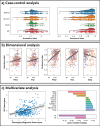A transdiagnostic study of theory of mind in children and youth with neurodevelopmental conditions
- PMID: 40685381
- PMCID: PMC12276665
- DOI: 10.1186/s13229-025-00671-3
A transdiagnostic study of theory of mind in children and youth with neurodevelopmental conditions
Abstract
Background: Theory of mind (ToM) is fundamental for social interactions, allowing individuals to appreciate that others have their own mental states. Children and youth with neurodevelopmental conditions (e.g., autism, attention-deficit hyperactivity disorder (ADHD), and obsessive-compulsive disorder (OCD)) often show differences in ToM abilities compared to their neurotypical (NT) peers. Given the phenotypic heterogeneity and overlap associated with these conditions, this motivates a transdiagnostic investigation of ToM across neurodevelopmental conditions.
Methods: Five hundred and fifty-five participants (5-22 years; 193 ADHD, 189 autism, 33 OCD, and 140 NT) were recruited via the Province of Ontario Neurodevelopmental Disorders network. To measure ToM, participants completed the Social Attribution Task (SAT), where participants attribute social stories to videos of moving shapes. The Animation Index (ability to attribute social stories to the videos) and Pertinence Index (how pertinent the attributions are) were calculated from the descriptions. Three analyses were performed: (1) a case-control analysis, comparing the SAT indices amongst the diagnostic groups, (2) a univariate dimensional analysis, examining associations with phenotypic variables (e.g., full-scale IQ, verbal IQ, and social communication difficulties), (3) and a multivariate analysis (partial least squares) that identifies a latent space that describes the associations between the SAT and phenotypic measures.
Results: There were no between-group differences in the Animation Index, but the Pertinence Index was significantly lower in autism compared to the other diagnostic categories. Phenotypic variables (full-scale IQ, verbal IQ, and social communication difficulties) were found to be significantly associated with SAT performance across groups, and explained more variance than the diagnostic categories. In the multivariate analysis, the phenotypic variables contributed more strongly to the identified latent component compared to the diagnostic categories.
Limitations: The verbal requirement of the SAT limited the inclusion of non-verbal participants, while the overall cognitive demand limited the participation of those with lower IQs. Additionally, our OCD group was significantly smaller than the other groups, which may have limited our ability to detect OCD-specific effects.
Conclusions: In a large sample, we found that transdiagnostic measures, such as IQ and social communication difficulties, are related to SAT abilities across neurodivergent and neurotypical children and youth and better describe differences in SAT performance compared to the individual diagnostic categories. Although poorer performance on ToM tasks has been classically associated with autism, this study highlights that transdiagnostic, phenotypic variables are a stronger predictor of SAT performance than diagnostic group.
Keywords: Development; Neurodevelopmental conditions; Social attribution task; Theory of mind; Transdiagnostic.
© 2025. The Author(s).
Conflict of interest statement
Declarations. Ethics approval and consent to participate: This study involves human participants and was approved by Holland Bloorview Kids Rehabilitation Hospital, Toronto (11–280); The Hospital for Sick Children, Toronto (1000012230); McMaster Children’s Hospital, Hamilton (12–050); Lawson Health Research Institute, London (103326); and Queen’s University, Kingston (6005107). All children and youth provided verbal assent, and parents gave written informed consent in accordance with the Declaration of Helsinki. Consent for publication: Not applicable. Competing interests: EA has received grants from Roche and Anavex, served as a consultant to Roche, Quadrant Therapeutics, Ono, and Impel Pharmaceuticals, has received in-kind support from AMO Pharma and CRA-Simons Foundation, received royalties from APPI and Springer, received an editorial honorarium from Wiley, and has a patent for holly™ (formerly Anxiety Meter). All other authors declare that they have no competing interests.
Figures

References
-
- Premack D, Woodruff G. Does the chimpanzee have a theory of mind? Behav Brain Sci. 1978;1(4):515–26.
-
- Sodian B. Theory of Mind in infancy. Child Dev Perspect. 2011;5(1):39–43.
-
- Frith C, Frith U. Theory of Mind. Curr Biol. 2005;15(17):R644–6. - PubMed
-
- Carlson SM, Koenig MA, Harms MB. Theory of Mind. Wires Cogn Sci. 2013;4(4):391–402. - PubMed
-
- Korkmaz B. Theory of Mind and neurodevelopmental disorders of childhood. Pediatr Res. 2011;69:101–8. - PubMed
MeSH terms
LinkOut - more resources
Full Text Sources
Medical
Research Materials

